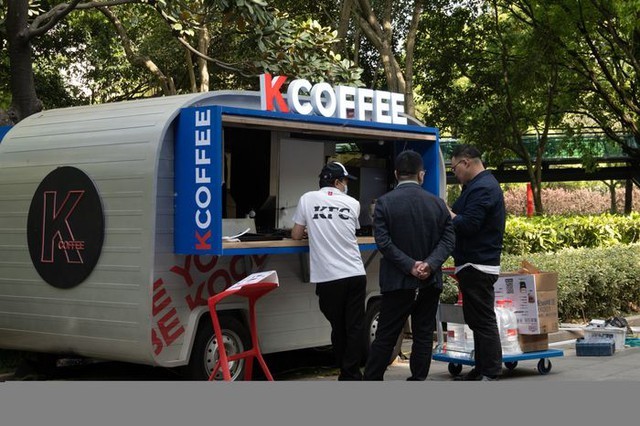For Americans, the pork-flavored coffee that Starbucks recently tested in China may seem like a bit of a stretch. But desperate times call for desperate measures. It’s no secret that Starbucks needs all the help it can get in China — the market where it introduced the coffeehouse culture a quarter century ago.
But there is another reason behind the gambit: Starbucks can no longer count on its core constituency, American customers, and it is being forced to fight for dominance in a vast market dominated by local companies. Unfortunately, that looks like a tall order.
There is no denying that Starbucks is a giant, of course. Since its original 165-store initial public offering in 1992, it has grown into a company that was once worth nearly $150 billion. But Starbucks has twice hit the wall in its history, and in both cases “savior” Howard Schultz had to return as CEO. The odds that Schultz will ride to the rescue of Starbucks a third time seem slim.
Since Schultz stepped down in September 2023 to make way for Laxman Narasimhan, the new CEO has had a nightmare of a first week. Traffic at Starbucks cafes in North America has fallen sharply for the first time since the depths of Covid, leaving analysts worried about consumer caution. Morgan Stanley analyst Brian Yarbrough noted that conditions were even worse than during the financial crisis.
Add to that the fact that same-store sales in China have fallen by an even bigger percentage. Starbucks shares have fallen by about as much as they did during the Covid-19 pandemic, when the chain was forced to close in March 2020. For its part, Starbucks management has blamed the poor results on everything from the weather . As of Wednesday’s close, the stock was down 56% over the past year, trailing the S&P 500 Index.
In a meeting with investors, Narasimhan kept referring to his “reinvention” plans, but it hardly seemed like enough.
In reality, the caution of American consumers might not matter much if Starbucks were still doing well in China — the market that Schultz in 2022 declared the chain’s most important.
To get there, Starbucks has set a goal of opening a new store in China every nine hours between now and 2025. Insane as that sounds, the context in the country is even more extreme. In the past year alone, the number of branded coffee shops in China increased by 58%, rising to about 50,000, according to World Coffee Portal. That works out to a new store every two to three hours, if you are counting. Does that sound excessive? Narasimhan told analysts on Tuesday that the average Chinese consumer drinks only 13 cups of coffee a year, compared with 380 in the U.S.
Yes, but there are already more coffee shops than there are in the U.S. And the Chinese market leader, Luckin Coffee, has more than double the number of locations as Starbucks. Just last year, it added more stores than Starbucks has managed in its entire 25-year history in the country. Upstart Cotti Coffee also claims to have roughly the same number of locations.
That’s happening as foreign and domestic companies crowd into the space. For example, Yum China, which operates the leading fast-food chicken chain KFC in China, said it sold some 50 million cups in its first quarter, up 30% from a year earlier. Many of those are going through its standalone KCoffee stores or kiosks. Similarly, McDonald’s, which also has a big restaurant presence in China, has been opening standalone McCafes and offering coffee delivery.
A more ominous threat is coming from foreign chains for which coffee isn’t a sideline. TH International, a major franchisee that is publicly traded on Nasdaq, entered China in 2019, two decades after Starbucks. It has grown its local loyalty program to about the same size as Starbucks and aims to have 2,750 stores nationwide by 2026.
Another challenge is tea, a competitive and historically favored drink in China that has also been growing rapidly. Several tea chains have recently gone public, but their stocks have languished amid the competition.
No. 3 chain ChaPa nda, with about 8,000 stores, is the latest to list in Hong Kong, in April. It noted in its prospectus that in China’s top 10 shopping areas there are about 50 tea shops within a 1-kilometer radius, with 10 in each of China’s top 10 malls.

New coffee brands are sprouting like mushrooms in China.
As with any business in such a situation, it would seem like a no-brainer for a company such as Starbucks to slash prices. However, company executives insist that they won’t do that.
“We are not going to do that, period,” Narasimhan said this week. “We’re a premium brand. We have built out a business for 25-plus years with a lot of moats around the business.”
That makes sense, up to a point. Like luxury handbags, Starbucks is what economists call a “Veblen good” — a product that becomes more desirable as its price increases. But by expanding to where it didn’t have a presence and introducing more Chinese to coffee, Luckin and Cotti are laying the groundwork for better-financed premium brands to profit down the road, one expert argues.
Starbucks is unlikely to reduce its prices to those low levels, obviously. But if it loses pricing power as it fights for market share, it will do so with its margins. And if it loses much more share, it may be the bargain hunters left holding the bitter cup.
By: WSJ





![[Photo Essay]: Experts, Managers, and Businesses Unite to Forge a Path Towards Sustainable Green Industry](https://xe.today/wp-content/uploads/2025/07/z678592918-150x150.jpg)


![[Photo Essay]: Experts, Managers, and Businesses Unite to Forge a Path Towards Sustainable Green Industry](https://xe.today/wp-content/uploads/2025/07/z678592918-100x70.jpg)



